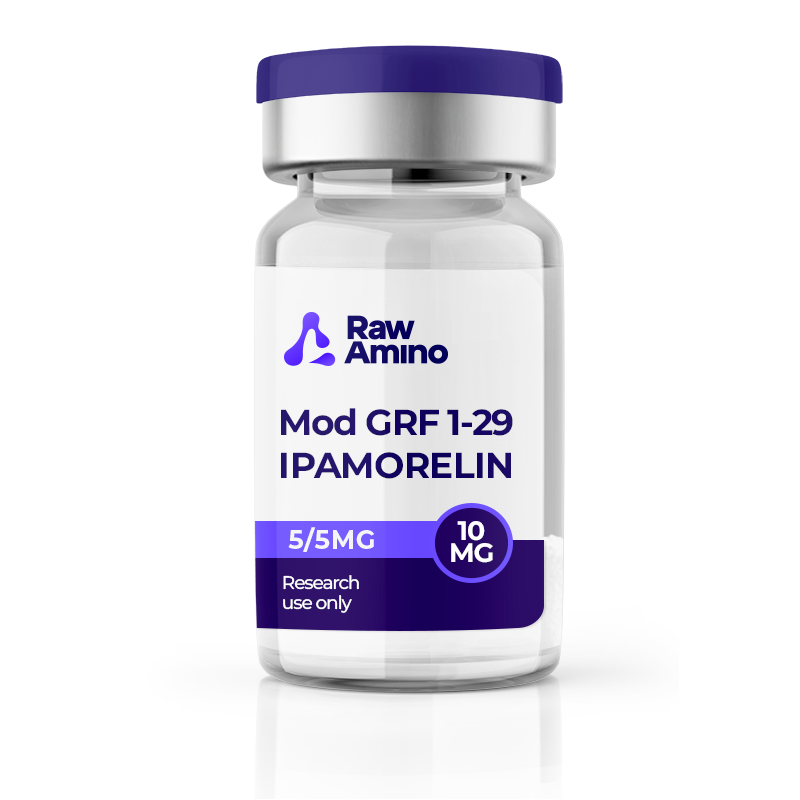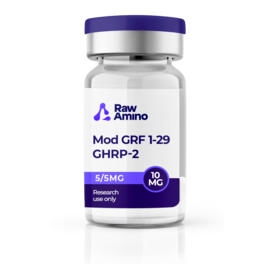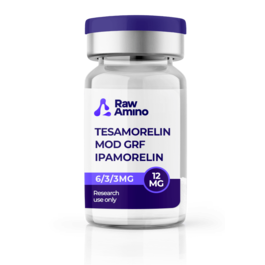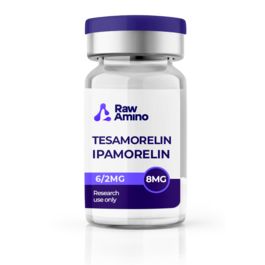
Mod GRF 1-29 & Ipamorelin – 10MG
$87.00
Discount per Quantity
| Quantity | Discount | Price |
|---|---|---|
| 5 - 8 | 5% | $82.65 |
| 9 + | 10% | $78.30 |
Scientific Overview of Mod GRF 1-29 & Ipamorelin Peptide Blend
Mod GRF 1-29 & Ipamorelin are synthetic peptides studied for their interactions with the growth hormone (GH) axis. Ipamorelin has been explored as a selective growth hormone secretagogue, functioning through ghrelin receptor pathways. Mod GRF 1-29, also referred to as Mod GRF 1-29, has been investigated as an analog of somatocrinin, with potential to stimulate growth hormone-releasing hormone (GHRH) receptors. Research suggests that when combined, these two peptides may influence GH regulation through complementary mechanisms.
Alternative Names: Mod GRF 1-29: CJC-1295 no DAC, Ipamorelin: NNC 26-0161
Mod GRF 1-29 & Ipamorelin Studies and Research Data
Research on Gastric Function and Ipamorelin
Studies indicate that Ipamorelin may contribute to gastrointestinal activity by interacting with ghrelin receptors. Experimental data suggest it may accelerate gastric emptying and support contractility of gastric smooth muscle under certain conditions. In rodent models, researchers noted a potential increase in food intake, body weight, and fat distribution associated with Ipamorelin, as well as changes in serum leptin levels that may be linked to appetite regulation.
Mod GRF 1-29 and Pituitary Pathways
Mod GRF 1-29 has been studied for its possible binding to GHRH receptors on pituitary cells. Findings suggest this interaction may trigger signal cascades involving second messengers such as cAMP, leading to downstream transcriptional activity related to GH synthesis. Observations in murine models of GHRH gene ablation point to possible normalization of growth indicators, including body weight, bone length, and lean mass, with concurrent increases in pituitary RNA and GH mRNA levels.
Combined Research on Mod GRF 1-29 & Ipamorelin
When introduced together, Mod GRF 1-29 and Ipamorelin may influence GH regulation through distinct yet complementary pathways. Ipamorelin appears to elevate baseline GH secretion, while Mod GRF 1-29 may sustain pulsatile activity. This interaction has been hypothesized to contribute to changes in nitrogen balance and protein metabolism. Studies suggest Ipamorelin may reduce hepatic urea synthesis during catabolic states, potentially normalizing nitrogen distribution across tissues. The different pharmacokinetics of the two peptides—Ipamorelin with a shorter half-life and Mod GRF 1-29 with a longer one—may contribute to both rapid and sustained activity in experimental systems.
Conclusion
Research on Mod GRF 1-29 & Ipamorelin highlights their potential roles in modulating growth hormone pathways. Ipamorelin has been studied for its selective interaction with ghrelin receptors, particularly in digestive and metabolic processes, while Mod GRF 1-29 has been investigated for its influence on pituitary-driven GH synthesis. When combined, they may operate synergistically, offering a model for studying both immediate and longer-term regulation of GH activity.
References
- Alba M, Fintini D, Sagazio A, Lawrence B, Castaigne JP, Frohman LA, Salvatori R. Once-daily administration of Mod GRF 1-29, a long-acting growth hormone-releasing hormone (GHRH) analog, normalizes growth in the GHRH knockout mouse. Am J Physiol Endocrinol Metab. 2006 Dec;291(6):E1290-4. doi: 10.1152/ajpendo.00201.2006. Epub 2006 Jul 5. PMID: 16822960.
- Martin, B., Lopez de Maturana, R., Brenneman, R., Walent, T., Mattson, M. P., & Maudsley, S. (2005). Class II G protein-coupled receptors and their ligands in neuronal function and protection. Neuromolecular medicine, 7(1-2), 3–36. https://doi.org/10.1385/nmm:7:1-2:003
- Teichman SL, Neale A, Lawrence B, Gagnon C, Castaigne JP, Frohman LA. Prolonged stimulation of growth hormone (GH) and insulin-like growth factor I secretion by Mod GRF 1-29, a long-acting analog of GH-releasing hormone, in healthy adults. J Clin Endocrinol Metab. 2006 Mar;91(3):799-805. doi: 10.1210/jc.2005-1536. Epub 2005 Dec 13. PMID: 16352683.
- Lall, S., Tung, L. Y., Ohlsson, C., Jansson, J. O., & Dickson, S. L. (2001). Growth hormone (GH)-independent stimulation of adiposity by GH secretagogues. Biochemical and biophysical research communications, 280(1), 132–138. https://doi.org/10.1006/bbrc.2000.4065
- Ionescu, M., & Frohman, L. A. (2006). Pulsatile secretion of growth hormone (GH) persists during continuous stimulation by Mod GRF 1-29, a long-acting GH-releasing hormone analog. The Journal of clinical endocrinology and metabolism, 91(12), 4792–4797. https://doi.org/10.1210/jc.2006-1702
- Aagaard, N. K., Grøfte, T., Greisen, J., Malmlöf, K., Johansen, P. B., Grønbaek, H., Ørskov, H., Tygstrup, N., & Vilstrup, H. (2009). Growth hormone and growth hormone secretagogue effects on nitrogen balance and urea synthesis in steroid treated rats. Growth hormone & IGF research, 19(5), 426–431. https://doi.org/10.1016/j.ghir.2009.01.001
- Greenwood-Van Meerveld, B., Tyler, K., Mohammadi, E., & Pietra, C. (2012). Efficacy of ipamorelin, a ghrelin mimetic, on gastric dysmotility in a rodent model of postoperative ileus. Journal of experimental pharmacology, 4, 149–155. https://doi.org/10.2147/JEP.S35396
- Venkova K, Mann W, Nelson R, Greenwood-Van Meerveld B. Efficacy of ipamorelin, a novel ghrelin mimetic, in a rodent model of postoperative ileus. J Pharmacol Exp Ther. 2009 Jun;329(3):1110-6. doi: 10.1124/jpet.108.149211. Epub 2009 Mar 16. PMID: 19289567.
- Raun K, Hansen BS, Johansen NL, Thøgersen H, Madsen K, Ankersen M, Andersen PH. Ipamorelin, the first selective growth hormone secretagogue. Eur J Endocrinol. 1998 Nov;139(5):552-61. doi: 10.1530/eje.0.1390552. PMID: 9849822.
- Newton, A. C., Bootman, M. D., & Scott, J. D. (2016). Second Messengers. Cold Spring Harbor perspectives in biology, 8(8), a005926. https://doi.org/10.1101/cshperspect.a005926
- Sinha DK, Balasubramanian A, Tatem AJ, Rivera-Mirabal J, Yu J, Kovac J, Pastuszak AW, Lipshultz LI. Beyond the androgen receptor: the role of growth hormone secretagogues in the modern management of body composition in hypogonadal males. Transl Androl Urol. 2020 Mar;9(Suppl 2):S149-S159. doi: 10.21037/tau.2019.11.30. PMID: 32257855; PMCID: PMC7108996.
Disclaimer:
The products mentioned are intended solely for laboratory research and in-vitro experimentation. They are not approved for human or animal use of any kind. All details provided are for educational purposes only. By purchasing from this site, you agree to comply with our Terms and Conditions.
Only logged in customers may leave a review.




Reviews
There are no reviews yet.